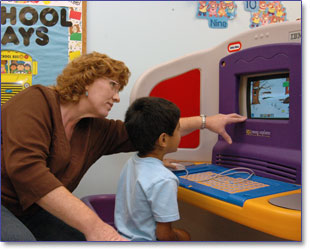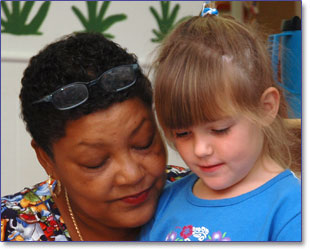  (Page 1 of 7) (Page 1 of 7)
Although typical preschool children already know
a lot about language, there are still many new
words and many new meanings of familiar words
for them to learn. There is also much to learn
about how to create and understand more complex
sentences. Children acquire language through extensive
exposure to good models of language use, but they
also need a lot of practice in using language
themselves. Let’s look at what you can do
in your preschool classroom to stimulate and support
language growth.
Talk with Children
One of the most important ways you can enhance your students’ language development is to talk with them—a lot. Children learn by listening to others and by expressing themselves. Children who have many conversations with adults learn more words and are better at putting words together in grammatically correct ways. These abilities have a tremendous influence on their later achievement in school.
 |
| |
 |
Try
to sit and talk with every child at least once
or twice every day. One-on-one conversations are
critical to supporting language development. Conversations
provide an opportunity for individual children
to have several turns to talk. Make it your goal
to spend several minutes talking individually with
each child in your class informally every day.
While this may seem overwhelming, it can be done.
Keep a checklist of your students handy. Plan for
time to talk with them. You can find time to talk
with your students throughout the school day: as
they come in each morning, during breakfast or
lunch, on the playground, during centers or snack
time, and in small group activities. Remember:
you need to sit, talk
and stay awhile, not cruise
around the room.
There are many ways you can
encourage children to talk more when you sit
and stay. One of the most effective ways
is simply showing a genuine interest in what they
have to say. More specifically, if you listen
carefully to what a child says and then expand
on what he says, you just might be surprised at
what he has to offer. Here are some tips for making
this happen.
Comment and Wait
First, comment on what child is doing and then
wait. When you follow the child’s lead
and wait for his/her response, you are encouraging
the child to use language. For example, if
a child is building roads in the block center,
you might walk up and comment, “These
are some interesting roads,” then pause
and wait for the child to respond to your comment.
|